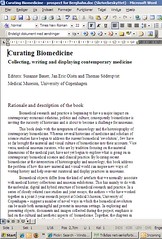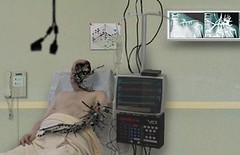We’ve just been hit by a chain-blog game started by Arte y pico [Top art] a few months ago: they asked five other blogs to recommend another five, and so forth, and now the chain is rattling along.
I wouldn’t have thought of participating if it hadn’t been for the fact that one of the most interesting and most beautifully illustrated medical blogs these days, The Sterile Eye by Norwegian clinical video photographer Øystein Horgmo, was the immediate precursor in this chain. Øystein recommends Monash Medical Student, Øystein in Antarctica (another Øystein!), IntraopOrate, Sushi Or Death — and Biomedicine on Display. In our case with these kind words:
Packed with interesting information and thoughts on medical history, both ancient and contemporary, reading this blog is like watching a making-of-documentary where the museum is the feature film. Always interesting.
On behalf of the Medical Museion blog team: Thank you, Øystein, very much appreciated!
Chain-blogs can be as awful as chain-letters once were. The chances that it will stop pretty soon are high, either because people don’t bother to continue or because they increasingly recommend blogs that have already been cited. This chain is pretty okay, though — it’s always nice to take a few minutes off to think about why one really likes some blogs more than others — and because I think The Sterile Eye is such a pleasure to read, I feel obliged to continue it. So, without having consulted with my co-contributors, I recommend the following five blogs which I find very inspiring for the kind of work we are doing here at Medical Museion:
1) First and foremost In the Pipeline, single-authored by Derek Lowe, a first-rate blog for anyone who wants to understand what goes on behind the scene in the pharma industry. Derek publishes almost daily, he knows what he writes about, keeps a professional distance to the events, yet is passionate about his job. The best science blog I’ve ever come across (the only drawback is that there are rarely any images).
2) Then Medgadget, founded by Michael Ostrovsky in 2004 and co-authored by a team of medical doctors and biomed engineers who write daily about “the latest medical gadgets and technologies, discoveries in medical science, and the progress of the digital revolution in the healthcare industry”. A must for anyone interested in med-tech and its impact on the medical system (the only drawback is that they apparently don’t care about the history and cultural context of the field).
3) Third, Relevant History — I link therefore I am by Alex Pang, a former historian of science who has transmogrified into a research director at the Institute for the Future, a Silicon Valley think tank. Alex is one of these creative and independent minds who combines solid humanistic scholarship with an ability to connect very different roads of thinking — and he also writes with a nice personal touch (see also his The End of Cyberspace) (the only drawback is that The End of Cyberspace looks a trifle dark and gloomy … like, well, the future).
4) I also love Bioephemera by Jessica Palmer, a Washington based biologist and artist who posts regularly about all kinds of odd things and images, with an emphasis on biological and medical stuff. A wonderful repository of curiosities and ephemera which might one day become the internet version of the classic Museum of Jurassic Technology (the only drawback is that Jessica’s blog has been included into ScienceBlogs which is a strong recommendation in itself; on the other hand this doesn’t necessarily disqualify her from getting this chain-post).
5) Finally, I wish to recommend bbgm (business, bytes, genes, molecules) by Deepak Singh, a Seattle-based “geek, business developer, strategist, marketer, technologist, scientist, global citizen, and musician” who writes about the social and business aspects of open science, collective intelligence, the semantic web, bioinformatics, drug development, medicine 2.0 etc. with equal gusto (only drawback is that I rarely have time to digest all the interesting content in the latest post before he has posted another).
The rules of this particular game limits the number of recommendations to five. Otherwise I would have added, for example, A Repository for Bottled Monsters by Mike Rhode and his friends/colleagues at the National Museum of Health and Medicine in Washington, DC; Street Anatomy by Vanessa Ruiz; and Indulge in the Fascinating World of Radiology and Nuclear Medicine by Hungarian medical students Imre Kissík and András Székely — all three are very useful for our combined research and curatorial project here at Medical Museion. And personally I’d like to push for a handfull of Swedish blogs, including Det Perfekta Tomrummet by Gustav Holmberg, mymarkup – old school and shit by Erik Stattin (about everything!), and Kuriosakabinettet by Karolina.
If you want to continue the game, see the rules here.

 No, it’s not spaghetti waiting to be served in the Medical School cafeteria — it’s intestinal worms (
No, it’s not spaghetti waiting to be served in the Medical School cafeteria — it’s intestinal worms ( Like many of our readers, the Biomedicine of Display blog team is taking some break periods here in August.
Like many of our readers, the Biomedicine of Display blog team is taking some break periods here in August. — contains a row of interesting works including, for example, Floris Kaayk’s ‘Metalosis Maligna’, “a fictitious documentary about a spectacular yet chronically disabling disease which affects patients who have been fitted with medical implants” (quote from
— contains a row of interesting works including, for example, Floris Kaayk’s ‘Metalosis Maligna’, “a fictitious documentary about a spectacular yet chronically disabling disease which affects patients who have been fitted with medical implants” (quote from  Take CT scanners for example: huge white or light blue plastic/metal boxes, that’s all.
Take CT scanners for example: huge white or light blue plastic/metal boxes, that’s all.